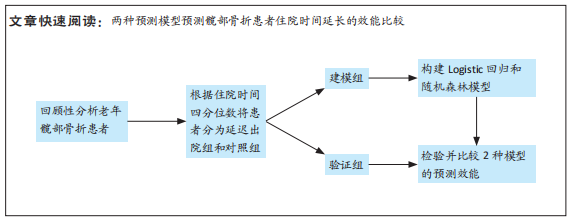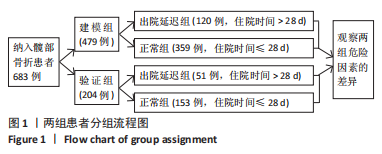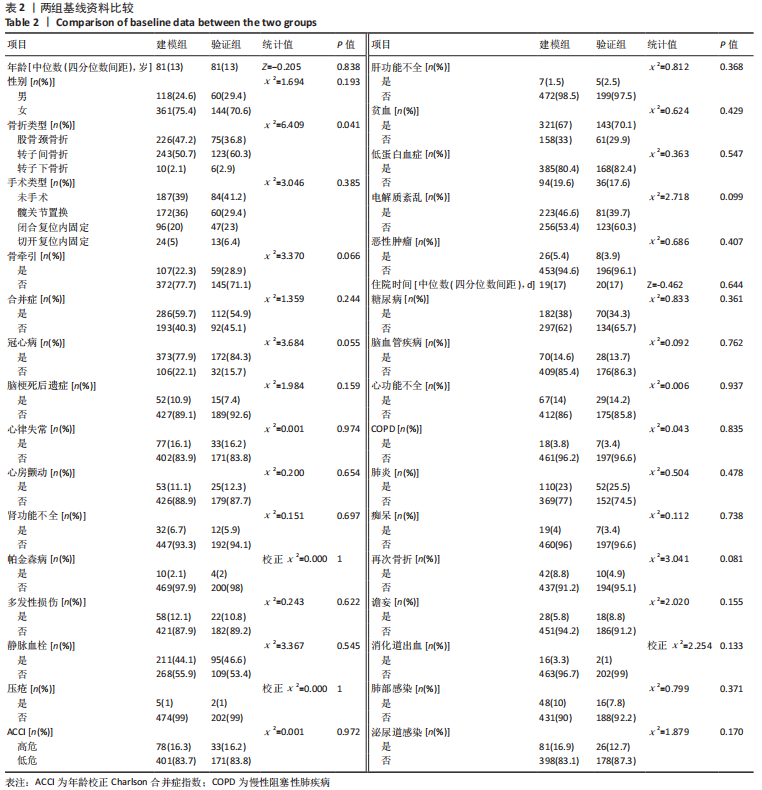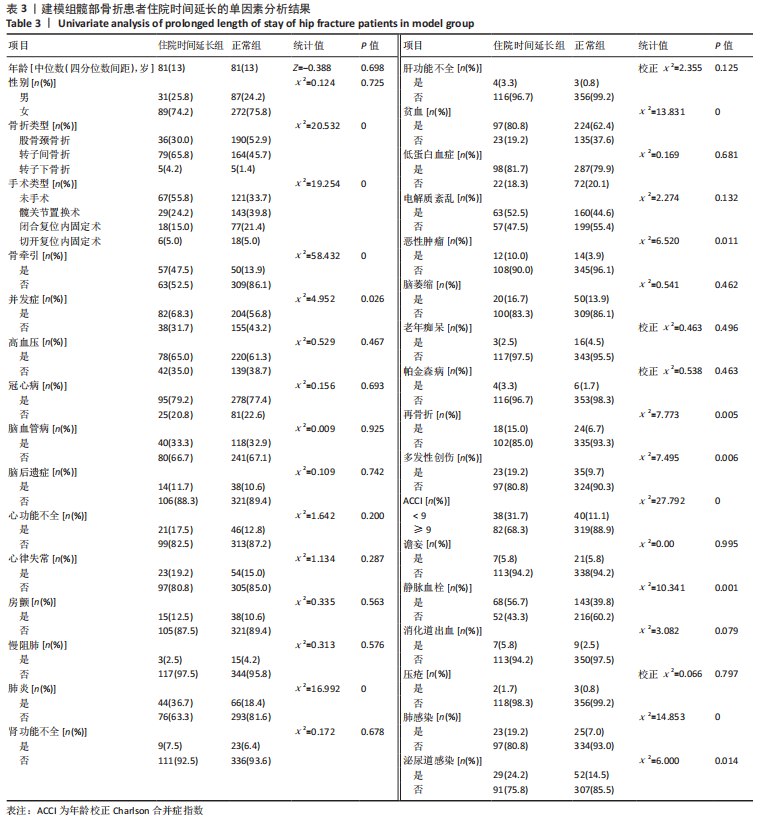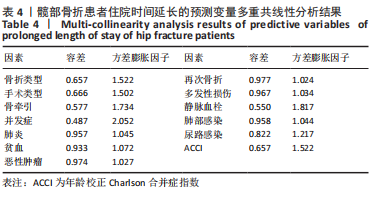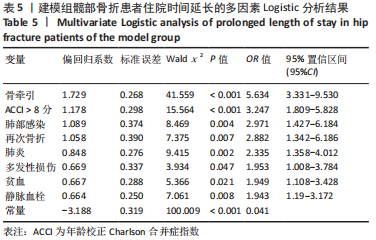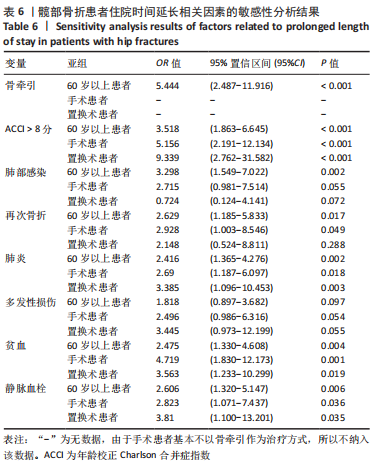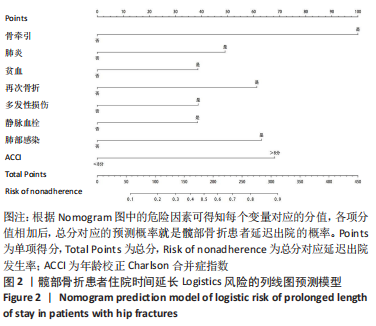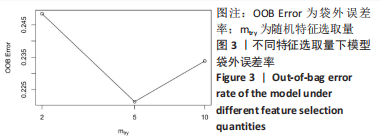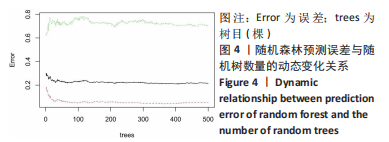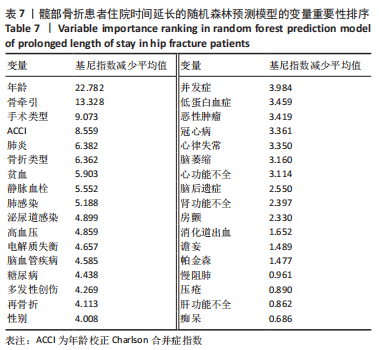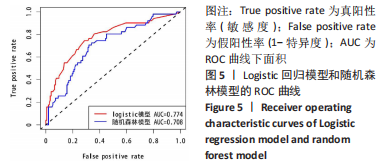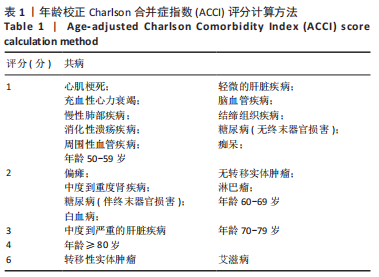[1] VERONESE N, MAGGI S. Epidemiology and social costs of hip fracture. Injury. 2018;49(8):1458-1460.
[2] BHANDARI M, SWIONTKOWSKI M. Management of acute hip fracture. N Engl J Med. 2017;377(21):2053-2062.
[3] LIM J. Big data-driven determinants of length of stay for patients with hip fracture. Int J Environ Res Public Health. 2020;17(14):4949.
[4] YOO J, LEE JS, KIM S, et al. Length of hospital stay after hip fracture surgery and 1-year mortality. Osteoporos Int. 2019;30(1):145-153.
[5] 刘强,胡永成.骨质疏松性骨折诊疗指南[J].中华骨科杂志,2017,37(1):1-10.
[6] 施毅.中国成人医院获得性肺炎与呼吸机相关性肺炎诊断和治疗指南(2018年版)[J].中华结核和呼吸杂志,2018,41(4):255-280.
[7] BATTLE DE. Diagnostic and statistical manual of mental disorders (DSM). Codas. 2013;25(2):191-192.
[8] 李晓强,张福先,王深明.深静脉血栓形成的诊断和治疗指南(第三版)[J].中国血管外科杂志(电子版),2017,9(4):250-257.
[9] CHOE HS, LEE SJ, YANG SS, et al. Summary of the UAA-AAUS guidelines for urinary tract infections. Int J Urol. 2018;25(3):175-185.
[10] RAO SJ. Regression modeling strategies: with applications to linear models, Logistic regression, and survival analysis. J Am Stat Assoc. 2003;98:461,257-258.
[11] 胡登炯.全髋关节置换治疗老年髋部骨折术后住院时间延长的相关因素分析[D].南昌:南昌大学,2021.
[12] 刘思源,唐晓宁,陈攀宇,等.全髋关节置换患者延迟出院相关危险因素分析[J].中华关节外科杂志(电子版),2021,15(5):521-527.
[13] 杨锐敏.影响老年髋部骨折住院时长的相关因素分析[D].广州:广州中医药大学,2021.
[14] WONG BLL, CHAN YH, O’NEILL GK, et al. Frailty, length of stay and cost in hip fracture patients. Osteoporos Int. 2022. doi: 10.1007/s00198-022-06553-1.
[15] EK S, MEYER AC, HEDSTROM M, et al. Hospital length of stay after hip fracture and it’s association with 4-month mortality-exploring the role of patient characteristics. J Gerontol A Biol Sci Med Sci. 2022;77(7):1472-1477.
[16] SHEIKH HQ, ALNAHHAL A, Aqil A, et al. Length of hospital stay following hip fracture and risk of 30 and 90 day mortality in a United Kingdom cohort. Acta Orthop Belg. 2021;87(4):607-617.
[17] NTULI M, FILMALTER CJ, WHITE Z, et al Length of stay and contributing factors in elderly patients who have undergone hip fracture surgery in a tertiary hospital in South Africa. Int J Orthop Trauma Nurs. 2020;37:100748.
[18] CASTELLI A, DAIDONE S, JACOBS R, et al. The determinants of costs and length of stay for hip fracture patients. PLoS One. 2015;10(7):e0133545.
[19] GREENSTEIN AS, GORCZYCA JT. Orthopedic surgery and the geriatric Patient. Clin Geriatr Med. 2019;35(1):65-92.
[20] WONG RMY, ZU Y, CHAU WW, et al. High Charlson Comorbidity Index Score is associated with early fracture-related complication for internal fixation of neck of femur fractures. Sci Rep. 2022;12(1):4749.
[21] WEI J, ZENG L, LI S, et al. Relationship between comorbidities and treatment decision-making in elderly hip fracture patients. Aging Clin Exp Res. 2019;31(12): 1735-1741.
[22] SHEN J, YU Y, WANG C, et al. Association of preoperative medication with postoperative length of stay in elderly patients undergoing hip fracture surgery. Aging Clin Exp Res. 2021;33(3):641-649.
[23] DI MONACO M, CASTIGLIONI C, VALLERO F, et al. Concomitant upper limb fractures and short-term functional recovery in hip fracture patients: does the site of upper limb injury matter? Am J Phys Med Rehabil. 2015;94(5):366-372.
[24] JUHASZ K, BONCZ I, KANIZSAI P, et al. Ellenoldali csípőtáji törésekkel összefüggő halálozás és kockázati tényezőinek vizsgálata [Analysis of mortality and its predictors in patients with contralateral hip fracture after femoral neck fracture]. Orv Hetil. 2017;158(20):783-790.
[25] TREVISAN C, BEDOGNI M, PAVAN S, et al. The impact of second hip fracture on rehospitalization and mortality in older adults. Arch Gerontol Geriatr. 2020;90:104175.
[26] 李宇能,刘昊楠,蒋协远,等.人工股骨头与全髋关节置换治疗老年移位型股骨颈骨折的成本效果分析[J].中国医刊,2019,54(10):1094-1098.
[27] NEWMAN JM, SZUBKSKI CR, BARSOUM WK, et al. Day of surgery affects length of stay and charges in primary total hip and knee arthroplasty. J Arthroplasty. 2017;32(1):11-15.
[28] SANTONI BG, DIAZ MA, STOOPS TK, et al. Biomechanical investigation of an integrated 2-screw cephalomedullary nail versus a sliding hip screw in unstable intertrochanteric fractures. J Orthop Trauma. 2019;33(2):82-87.
[29] NISSENHOLTZ A, LEVY Y, COOPER L, et al. Anemia in patients after hip fracture repair surgery. Harefuah. 2020;159(9):689-693.
[30] 全静,谌旻欢,董璐,等.髋关节置换者术前血红蛋白水平与住院时间的相关性[J].贵州医科大学学报,2022,47(5):581-587.
[31] 张丽,张春雷.围术期异体输血对骨科大手术患者凝血功能和免疫功能的影响[J].中国现代医药杂志,2020,22(12):49-52.
[32] GUPTA S, FERNANDES RJ, RAO JS, et al. Perioperative risk factors for pulmonary complications after non-cardiac surgery. J Anaesthesiol Clin Pharmacol. 2020; 36(1):88-93.
[33] SALARBAKS AM, LINDEBOOM R, NIJMEIJER W. Pneumonia in hospitalized elderly hip fracture patients: the effects on length of hospital-stay, in-hospital and thirty-day mortality and a search for potential predictors. Injury. 2020;51(8):1846-1850.
[34] BLASI F. Lung diseases: chronic respiratory infections. Int J Mol Sci. 2018;19(10):3051.
[35] TRIVEDI NN, ABOLA MV, KIM CY, et al. The incremental cost of inpatient venous thromboembolism after hip fracture surgery. J Orthop Trauma. 2020;34(4):169-173.
[36] FENG L, XU L, YUAN W, et al. Preoperative anemia and total hospitalization time are the independent factors of preoperative deep venous thromboembolism in Chinese elderly undergoing hip surgery. BMC Anesthesiol. 2020;20(1):72.
[37] 李斐雯,李萍,白春花.基于机器学习的肾移植受者术后抑郁的预测模型建立[J].中国临床研究,2022,35(8):1168-1172.
|
